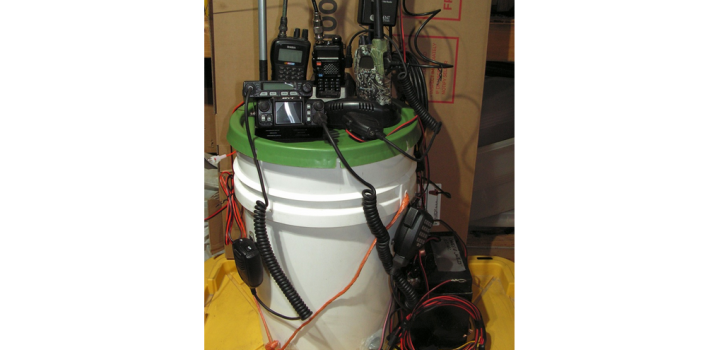Introduction
This five-part article is about a low-power communications station that fits into a 6-gallon plastic bucket that can be operated in or out of a bucket, or perhaps two buckets. Included are tips to help maintain the station, and improve its effectiveness. Some can afford to buy better equipment, and some will also be interested in gathering Signals Intelligence (SIGINT). I believe that SIGINT will become essential in the future. This example was put together on a tight budget, so I can afford to make several communications stations, and still perform SIGINT and use digital modes. We should assemble several basic stations first, and then later, work on making these stations more capable.
I recommend that you obtain the basics first, and skip the items on the list labeled as “optional”. Ultimately the reader decides what goes in the bucket, and if there is a need for a second bucket that supports the first. A basic station will fit into one bucket that includes a small storage battery, and a small foldable PV panel array. Ready Made Resources offers a 21-watt foldable panel that is a good candidate. A copy of this article, and The Guerilla’s Guide to the Baofeng Radio, along with frequency lists, a brevity code, operators manuals, and notes can be added to the bucket. That way, in the event that I become MIA, my friends can pick it up and use it.
About the Author
I have 40 years of experience operating analog and digital transceivers, first as an emergency services dispatcher, and later, with daily operation of the ‘start of the art’ P-25 (digital) transceivers, and Mobile Data Terminals (MDTs). However, most of what I know about this niche topic required the recent 10+ years of learning on my own. I began using FLdigi via audio coupling over VHF more than 10 years ago, well before it became popular. My local Ham buddies had no interest in that, or NVIS propagation techniques. Sadly, many Amateur Radio Operators are not likely going to endorse an article like this, or some of these ideas in general. How a survivalist would approach radio is necessarily different than how Amateurs Radio enthusiasts would approach “field day” radio. We must think outside of the box, rather than remain within the confines of a paradigm.
The Guerilla’s Guide to the Baofeng Radio
The book The Guerilla’s Guide to the Baofeng Radio by “NC Scout” is a must-have reference for every owner of a Baofeng with plans to use them in field operations. This article describes a departure from that book, in some designs and techniques. Adding photos provides additional information. Note that I have several articles on communications and off-grid power in the SurvivalBlog archives that would provide supporting information that dovetail with this article. To find them, just type “Tunnel Rabbit” in the blog’s search box.
While The Guerilla’s Guide to the Baofeng Radio book is geared toward military operations, this article is more from the prepper’s perspective, or what the book defines as a communications station in a bucket.
An Overview
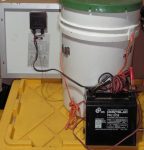 In the realm of Amateur Radio, or military communications, most of these ideas are not new, yet nowhere have I seen a proper ‘commo bucket build’ described in detail. It is essentially a low-powered communications station package, or a mini ham shack for preppers in a bucket that is compact enough to grab and go, and can be stored and protected by the bucket while in long-term storage, or out in the field. It should be versatile enough to perform most of the essential tasks that a regular communications station could. It is an attempt akin to the challenge of stuffing an emergency survival kit into an Altoid can. As little or a lot of money can be invested, however, how much we spend does not mean that the station is proportionally more capable.
In the realm of Amateur Radio, or military communications, most of these ideas are not new, yet nowhere have I seen a proper ‘commo bucket build’ described in detail. It is essentially a low-powered communications station package, or a mini ham shack for preppers in a bucket that is compact enough to grab and go, and can be stored and protected by the bucket while in long-term storage, or out in the field. It should be versatile enough to perform most of the essential tasks that a regular communications station could. It is an attempt akin to the challenge of stuffing an emergency survival kit into an Altoid can. As little or a lot of money can be invested, however, how much we spend does not mean that the station is proportionally more capable.
In reality, two hands could be necessary to carry accessories as such a larger PV panel that would be needed in northern latitudes, or a second bucket that supports and expands the station’s capabilities. A small folding type PV panel could be adequate for your purposes, and be placed inside a bucket. Or there could be larger 100-watt folding panel in a second bucket, and a larger deep-cycle storage battery that would be advantageous to have for the long term. The low cost of this station means we can create an alternative, or second, or ideally, a third Commo Bucket stored elsewhere. The bucket could contain two mobiles, and 6 hand held transceivers, a scanner, an Android, a shortwave radio, and a list of components that together are capable of 10 Meter, CB, 2 meter, 1.25cm, 70cm, MURS, GMRS, and more. See the list for the entire contents. Or we can delete the items listed as ‘optional’, and build a basic station first. This would be the best approach.
I advise you to assemble at least two stations before investing in the advanced station that includes items listed as ‘optional’ equipment.
A Swiss Army Knife Approach
This design is a good one, because it is versatile, prepper centric, and it is easy to modify and adapt to a dystopian future. It is a Swiss Army Knife kind of design.
The contents could be removed from the bucket to establish a traditional radio shack, or low-power base station. This design allows the user to attach a variety of external antennas, and to use variety of external or internally stored power sources that would be available in austere conditions. A variety of battery types and sizes can be used inside the bucket as there is plenty of room. It is a versatile and rugged, and relatively easy-to-build platform that uses mostly common hardware and household items. This bucket design is light enough to be transported by backpack by strapping it to a Medium Alice pack (preferably with a cargo shelf), or another external frame pack, and fits inside a large Alice pack, or other larger bucket-type pack that has an opening of more than 12 inches in diameter. Or, the heavy internal components can be removed and carried in any smaller-sized pack, and the empty bucket can be carried by hand, or strapped to the pack.
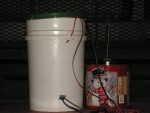 When fully packed, it is surprising just how much can fit in, and how heavy a small AGM battery can make it. A lithium storage battery is an option. But keep in mind that they are more expensive and require the newer type of charge controller designed to work with lithium. Also, consider that the electronics inside the lithium battery that regulate the charging process needed could possibly be damaged by EMP. A lithium storage battery needs to be small enough to be able to fit inside a Faraday cage. There is also the risk of fire with certain types of lithium batteries. It could be worth the expense, and time to thoroughly research the matter.
When fully packed, it is surprising just how much can fit in, and how heavy a small AGM battery can make it. A lithium storage battery is an option. But keep in mind that they are more expensive and require the newer type of charge controller designed to work with lithium. Also, consider that the electronics inside the lithium battery that regulate the charging process needed could possibly be damaged by EMP. A lithium storage battery needs to be small enough to be able to fit inside a Faraday cage. There is also the risk of fire with certain types of lithium batteries. It could be worth the expense, and time to thoroughly research the matter.
I prefer deep-cycle lead acid batteries, because they are time-tested, and can tolerate abuse. The metal can houses all electronics that would protect it from EMP. It is a Faraday cage when the seam of the lid is taped with aluminum HVAC duct tape. Use desiccant inside. It is stored inside the 6-gallon bucket with coaxial cable, antennas, and all the other accessories and tools to support a base station, as well as 6 transceivers, and a repeater for a complete low-power communications system.)
The bucket can contain all the basic equipment to supply a low power base station. A photo does not capture all of the equipment. The metal can is a Faraday cage, and a protective container for external storage. Packing the bucket involves choosing that which is important for your purpose. Given its mission at a future date, items can be temporarily removed to reduce weight, and to make space that allows equipment to be operated while protected from the elements when inside the bucket. Coaxial cable, and power from an external battery and PV array enter the bucket through a hole that is sealed, and making it easy to connect the transceiver to an external antenna, and power source. The two microphones can be slipped outside through a space between the lid and rim of the bucket.
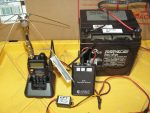 As someone who has done a good deal of camping using tarps, high winds can drive rain underneath, or perhaps dislocate the tarp partly, allowing rainwater to infiltrate the radio equipment that is not designed to be water-resistant. This equipment would likely not be easily replaced, and should be protected at all times. The bucket and the metal can would be necessary to protect the equipment, and can also serve as tiny tabletops when in the field. So much equipment can be packed inside the bucket that this photo cannot properly capture all of it. It is representative only. The photo shows the back side of a 10-watt PV panel. The cardboard boxes that serve as a backdrop contain two 100-watt Renogy PV panels.
As someone who has done a good deal of camping using tarps, high winds can drive rain underneath, or perhaps dislocate the tarp partly, allowing rainwater to infiltrate the radio equipment that is not designed to be water-resistant. This equipment would likely not be easily replaced, and should be protected at all times. The bucket and the metal can would be necessary to protect the equipment, and can also serve as tiny tabletops when in the field. So much equipment can be packed inside the bucket that this photo cannot properly capture all of it. It is representative only. The photo shows the back side of a 10-watt PV panel. The cardboard boxes that serve as a backdrop contain two 100-watt Renogy PV panels.
Note: Always do a function test on newly-delivered panels.
The bucket, when fully loaded, the Faraday cage inside the bucket, and the surrounding space outside the Faraday cage (a large metal popcorn can) may contain:
1 6 gallon plastic bucket (with a gasketed lid.)
1 As a Faraday cage, a medium or large-sized popcorn metal can, or equivalent. Available at thrift stores.
3 to 6 Baofeng UV5R Transceivers
1 Compact SWR meter (spend at least $100 for a decent one, and get two that are from different manufacturers. We can then verify the accuracy of each meter, just as we would a compass, by comparing their results.)
1 Midland GXT950 Extra Talk transceiver. This is intended as a very low-power transceiver for the Argent data system simplex repeater. (optional)
1 Uniden scanner with Close Call with an attached external antenna. An external antenna makes the Close Call feature much more sensitive to weaker signals.
1 Anytone Smart 10 Meter AM/FM and 16 watt PEP CB AM/FM, and 400 channelized frequencies between 24 and 30 Mhz. A CB is probably the better choice for most. (optional)
1 A CB that replaces the Anytone Smart. Uniden handheld CBs are small in size, and lowest in cost (A BNC-to-SO239 adapter would be needed.)
1 QYT KT9000D Quad band. Maximum output 22 watts given the frequency used. This can be substituted any dual-banded mobile transceiver with a signal strength meter.
1 Kaito shortwave radio. Receives shortwave broadcasts and the HF Ham bands, AM and SSB. (optional)
1 SURCOM Frequency Counter (optional)
2 Coaxial cables, 25 feet in length.
1 Moxon directional antenna for UHF. Or any compact directional antenna. (optional)
1 compass to determine an approximate line of bearing.
2 Wire dipoles, one for 1.25CM (optional), and one for 2 Meter/MURS.
1 Wire dipole for CB
1 Wire dipole for 10 Meter (optional)
1 50 feet of paracord and a weight of some kind to toss it over a tree branch.
2 UHF 1/4 wave ground plane or dipole antennas, one for GARS, and one for 70cm
2 10 to 12 inch in length 3/4 inch plastic pipe for the antenna mast
1 Argent Data Systems’s simplex repeater (optional)
2 Repeater boxes for crossband repeaters comprised of 2 Baofeng transceivers. (optional)
1 roll of electrical tape.
8 wire nuts to make or repair wire antennas, and to connect ad hoc electric supply wire.
1 Assorted coaxial cable adapters and PL259 cable ends.
1 Multi-tool
1 12vdc automotive incandescent test lamp (EMP proof), or multi-meter for checking the continuity in coaxial cables, and power supply wires.
1 Tape measure needed to make or repair antennas.
1 Radio Shack’s Solder Weld part #64-029. This is a silver-bearing paste that can solder connections with only the heat from a lighter. (optional)
1 flux for soldering and a roll of solder, 0.8mm wire.
1 small butane torch (optional)
1 soldering iron
1 standard-size propane torch
1 Small roll of clear packing tape to repair a PV panel. (optional)
1 20Ah PWM charge controller. (Morningstar Sun Saver Duo is best. Charges two separate batteries simultaneously.)
1 Small 7Ah or greater in capacity SLA battery.
1 Deep cycle storage battery (two 6-volt golf cart batteries), or deep cycle AGM (best), or lithium battery if you can afford the charge controller and can protect it in a Faraday cage.
2 Voltage step-down devices from 12 vdc to 9 vdc. (See my article: Commo for Family, Group and Community that explains this item.)
1 RTL-SDR dongle (optional)
1 Bootable USB with Skywave Linux that has all the needed software such as FLdigi and others. (optional)
1 Preprogrammed Android tablet (optional)
1 programming cable for Baofeng transceivers (optional)
Additional Details
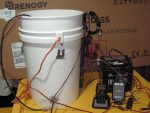 With a lithium or AGM storage battery that has a low self-discharge rate inside the bucket, the bucket can be stored for at least one year, and be ready to use. If using a sealed lead acid battery (SLA), the self-discharge rate is 1 to 3% per month, therefore frequent maintenance would be needed to ensure the battery is fully charged, and to preserve its capacity to hold power into the future. The storage battery stored inside the bucket can be checked, and charged externally by installing a wire that runs through the bucket. Study the photos to see how it was done on this bucket.
With a lithium or AGM storage battery that has a low self-discharge rate inside the bucket, the bucket can be stored for at least one year, and be ready to use. If using a sealed lead acid battery (SLA), the self-discharge rate is 1 to 3% per month, therefore frequent maintenance would be needed to ensure the battery is fully charged, and to preserve its capacity to hold power into the future. The storage battery stored inside the bucket can be checked, and charged externally by installing a wire that runs through the bucket. Study the photos to see how it was done on this bucket.
All that is needed is a paint job, a PV panel, and an old laptop for the RTL-SDR dongle, and FLdigi. An Android is a smaller package that draws less power, and it can send photographs as a part of a SALUTE report. It is a better choice than a laptop for digital signals. We would then have a very capable, portable communications, and SIGINT (Signals Intelligence) station. Notes on the photo: Coaxial cable and power supply wiring can be seen going into, and out of the bucket. The inlet is sealed with a clear RTV adhesive silicone.)
If you can build antennas and install cable ends, and have a modest level of ability to fabricate, the cost is lower and you have the necessary skills to keep the station in operation. My rough estimate: less than $500 for a basic example that may include everything except the items that are denoted as ‘optional’. All of the antennas shown are not for sale anywhere, they were fabricated for this station in a bucket, so you’ll have to make them, or find substitutes for sale. There are plenty of instructional videos available on YouTube. An SWR meter is a necessity, and it is easy to make a dipole antenna that is the most compact antenna, and is ideal for this station in a bucket model. Commercially made antennas could be used for a typical station.
The Argent Data System Simplex Repeater, and a cable for the cross band repeater, the various transceivers, charge controller, and other electronics are contained inside the same large metal can as an additional layer of protection from the elements, and as protection against damage from EMP or CME while in storage. Once placed into service, holes can be drilled to allow cable and wire into the inside the metal can. An important advantage is that the sensitive electronic equipment would be sealed inside two water-tight containers that each contain packets of desiccant. When the repeater is in use, it can be separated from a charge controller, and a lead acid battery when these are installed for operation. A charge controller, if exposed to the RF of transceivers, can have its function disrupted.
The Commo Bucket can be placed on the ground with an attached external antenna that is mounted on the blue mast, and there can be another antenna that can be detached and hoisted up high into a tree, or housed inside the bucket itself, or the bucket itself hoisted up into a tree. Placing the entire unit off the ground will protect it from bears, and other animals. Bears like to chew on plastic even if the plastic container has gasoline in it, and can puncture the bucket wall with their claws. Suspending it in a tree is the best way to protect it if it is to be left unattended in the woods. A PV panel should be located where the sun shines best. For the purpose of concealment, located the PV panel in bushes, and orient the panel directly upward toward the sky to avoid reflections off of the panel’s shiny surface that can act like a signal mirror to those on the ground.
Even though there is a 30 percent loss in production with horizontally-mounted panels, a 10-watt panel is adequate as it was tested for simplex repeater operation, and the charging of two hand helds. The panel will also keep two Baofeng UV5R transceivers turned on, and receiving 24/7 during the more sunny 6 months of the year without the use of a charge controller, or even a storage battery, when using the voltage step-down converter detailed elsewhere. (Again, see my previous SurvivalBlog article: Commo for Family, Group, and Community.)
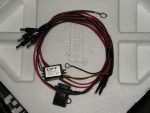 This is a photo of the device as assembled with 2.5 mm barrel connectors that fit Baofeng UV5R, and Midland GXT charging bases. Adding a cigarette plug end can make it convenient to use inside a vehicle, and to connect a small sealed lead acid (SLA) battery that powers the Argent Data System Simplex Repeater.)
This is a photo of the device as assembled with 2.5 mm barrel connectors that fit Baofeng UV5R, and Midland GXT charging bases. Adding a cigarette plug end can make it convenient to use inside a vehicle, and to connect a small sealed lead acid (SLA) battery that powers the Argent Data System Simplex Repeater.)
(To be continued tomorrow, in Part 2.)

